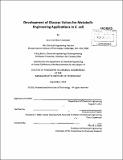Development of glucose valves for metabolic engineering applications in E. coli
Author(s)
Solomon, Kevin Val-Murvin
DownloadFull printable version (15.72Mb)
Other Contributors
Massachusetts Institute of Technology. Department of Chemical Engineering.
Advisor
Kristala Jones Prather.
Terms of use
Metadata
Show full item recordAbstract
Microbial production platforms have extraordinary potential to help meet the energy, material and health needs of tomorrow. Through the reactions of cellular metabolism, microbes are an attractive option for the sustainable production of commodity and enantiopure specialty chemicals. One outstanding challenge, however, is the engineering of these systems for economic viability. As a solution to this issue, a metabolite valve is proposed: a biochemical device which may be used to dynamically redirect metabolite flux away from endogenous processes into production pathways. In this work, we develop and characterize a glucose valve. First, a novel E. coli strain was engineered to allow the redirection of glucose flux from central metabolism via glucokinase. Using a promoter library, glucokinase expression was varied with an attendant change in specific growth rate and carbon flux. A model pathway was then constructed to utilize the redirected carbon demonstrating that the efficiency of such pathways may be controlled through glucokinase expression. Next, inducible antisense RNA and inverting genetic circuits were developed to dynamically control glucokinase expression. With dynamic control, carbon was redirected from endogenous processes only once sufficient cellular resources had accumulated, further improving performance. In this manner, yields and titers of the model pathway were increased with a concomitant decrease in acetate waste. Finally, elements of this system were modeled to gain mechanistic insight and to establish a control envelope of viable expression and production regimes. This thesis represents one of the first reports of glucose redirection in E. coli and is an example of the ongoing development of a relatively new paradigm in metabolic engineering: dynamic flux control. With a glucose valve, the needs of cellular health and demands of heterologous production may be balanced, enabling the development of efficient processes with glucose as a sole carbon source for both cell growth and biochemical production. This ability to use a single carbon source simplifies process design, lowering capital and operating costs. Furthermore, a glucose valve has potential applications in the optimization of existing processes where carbon is underutilized and wasted as fermentation products such as acetate.
Description
Thesis (Ph. D.)--Massachusetts Institute of Technology, Dept. of Chemical Engineering, 2012. Cataloged from PDF version of thesis. Includes bibliographical references (p. 104-120).
Date issued
2012Department
Massachusetts Institute of Technology. Department of Chemical EngineeringPublisher
Massachusetts Institute of Technology
Keywords
Chemical Engineering.